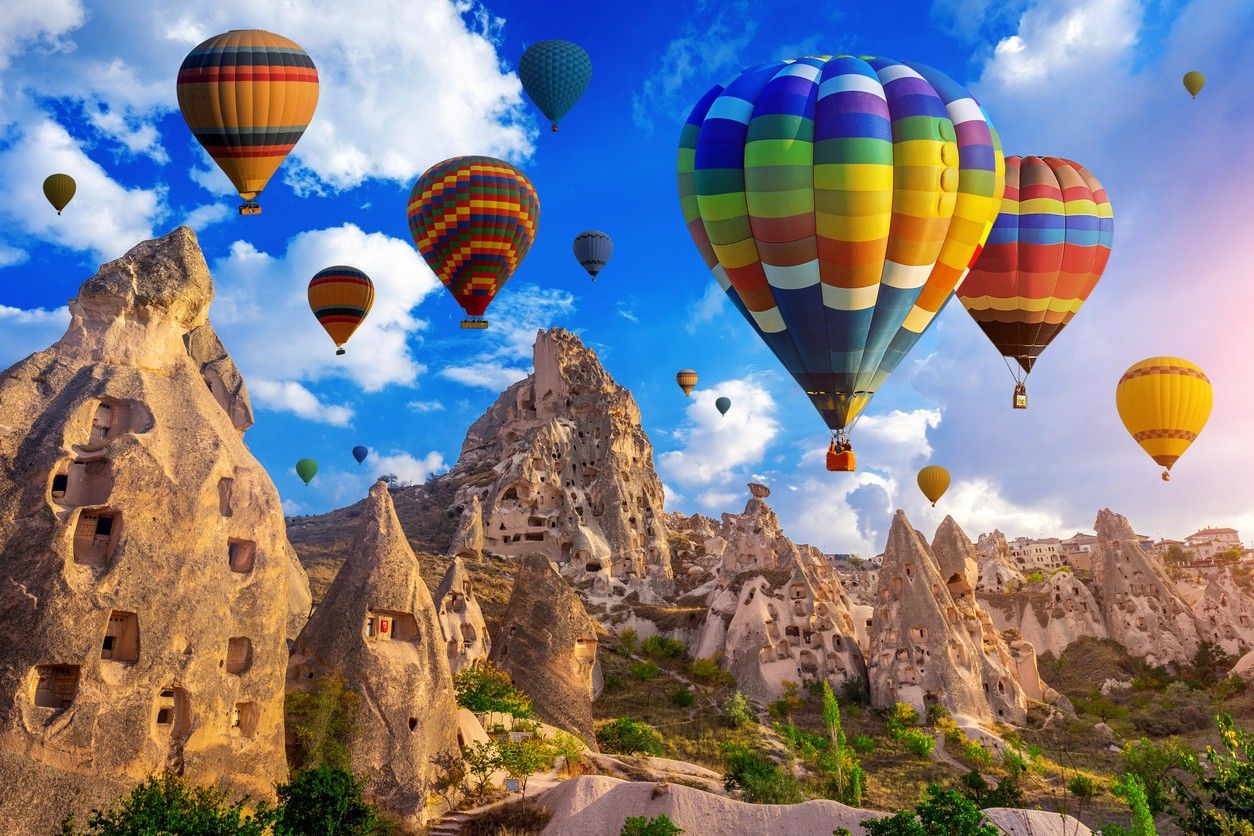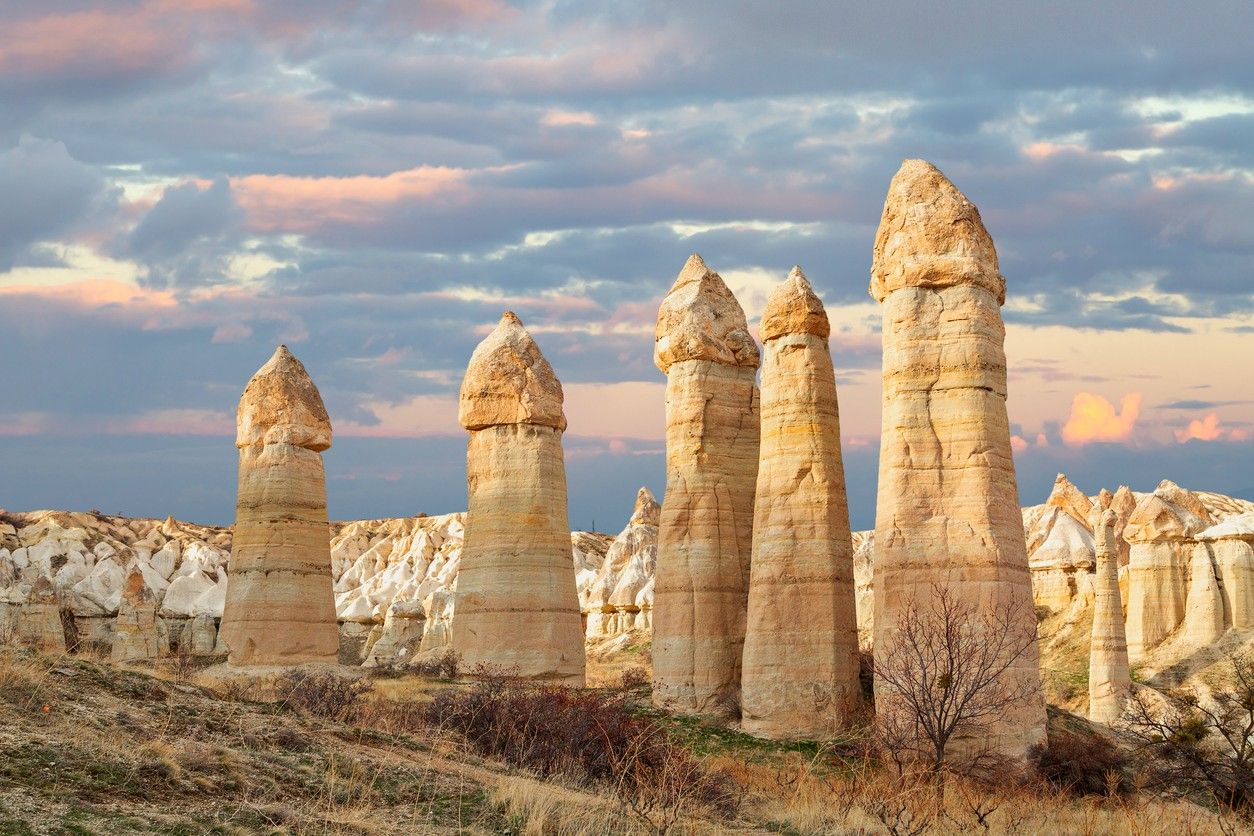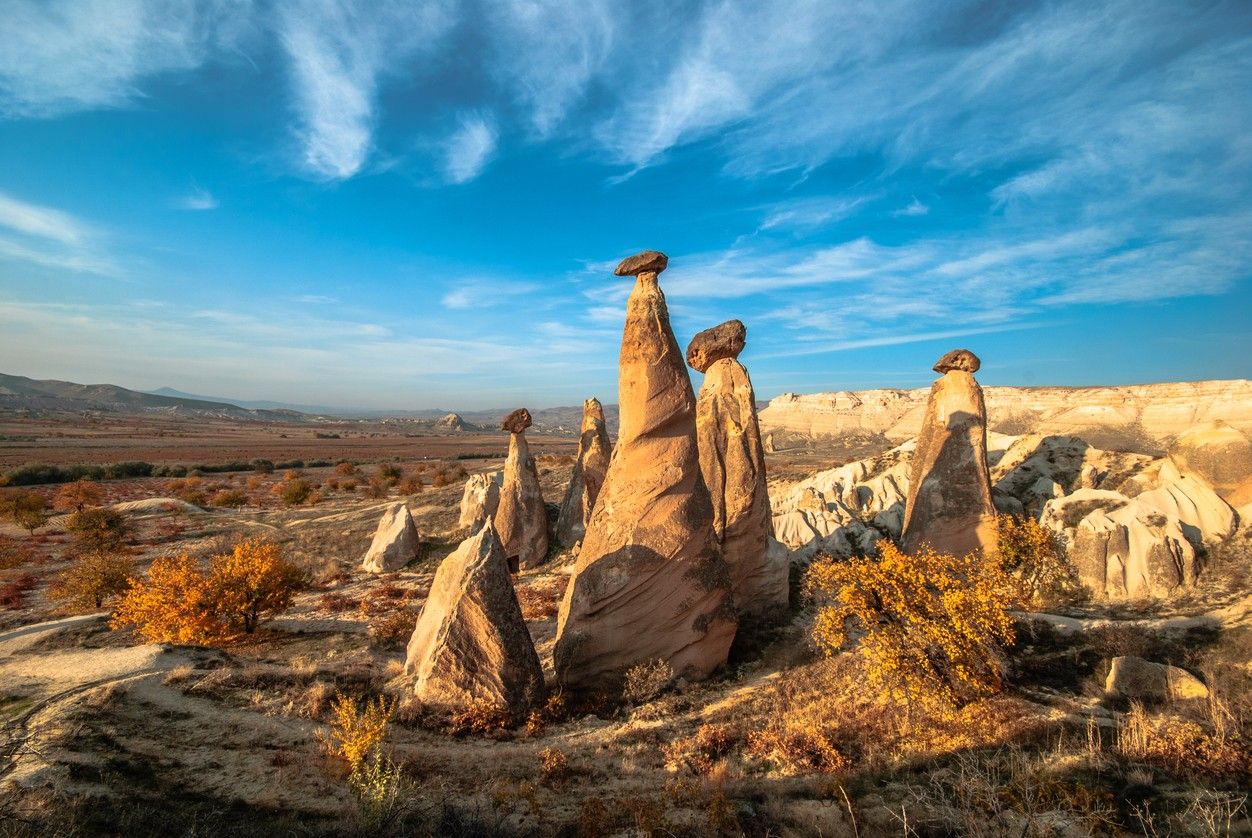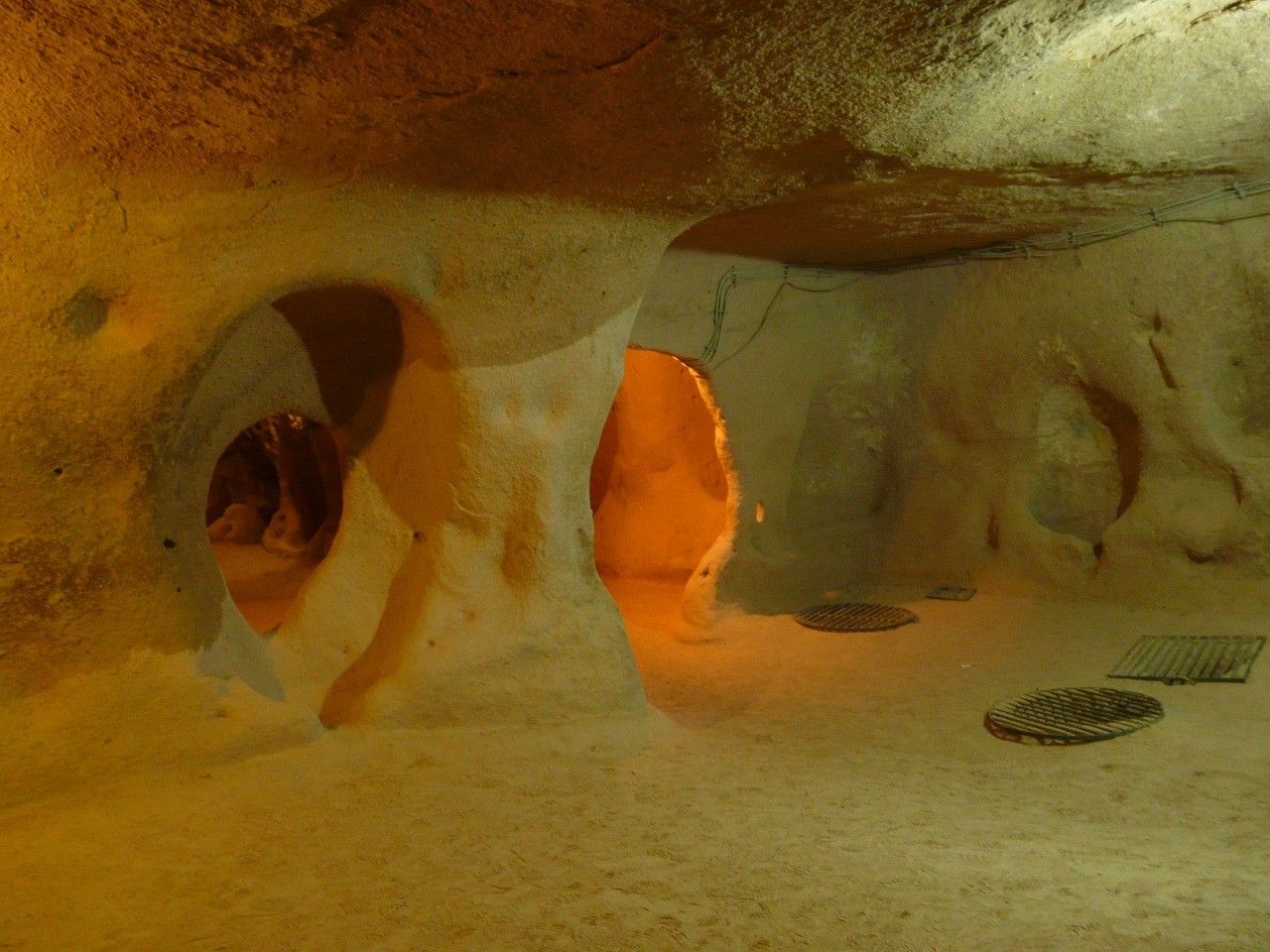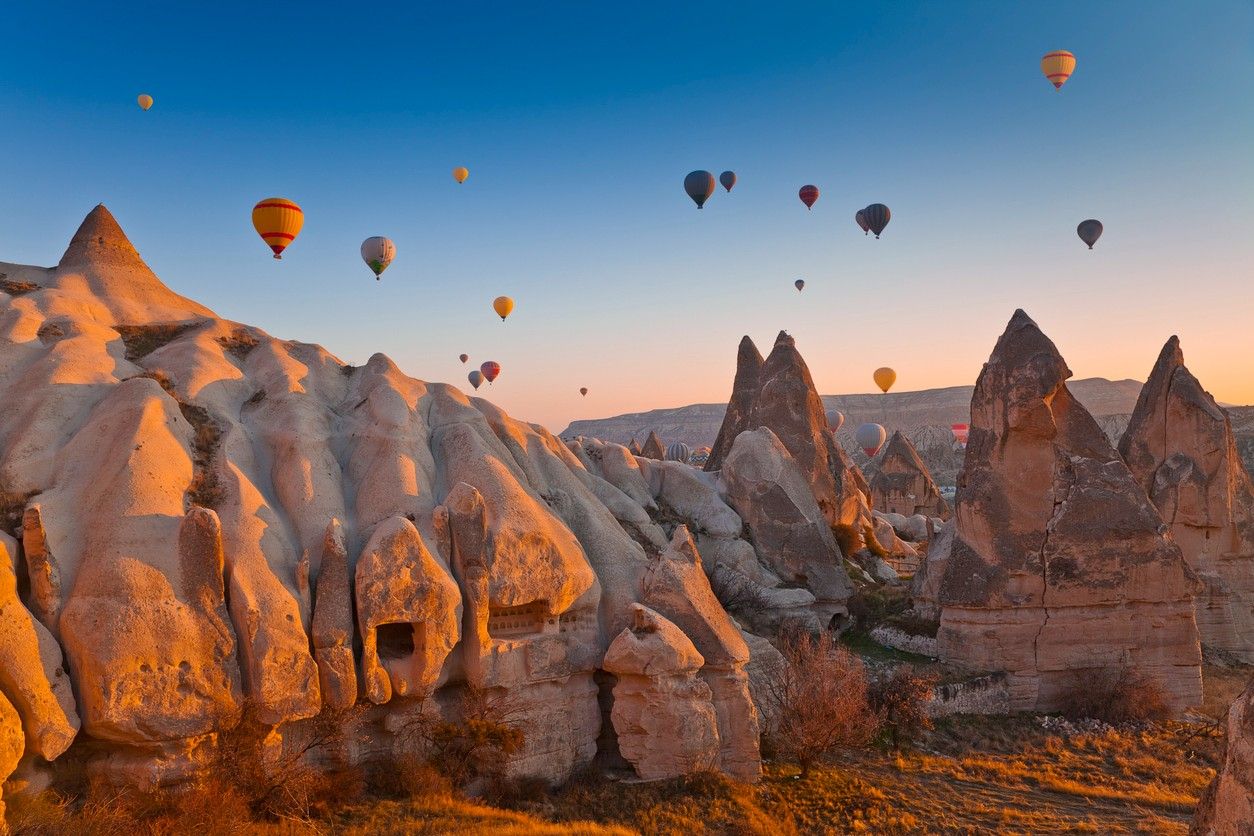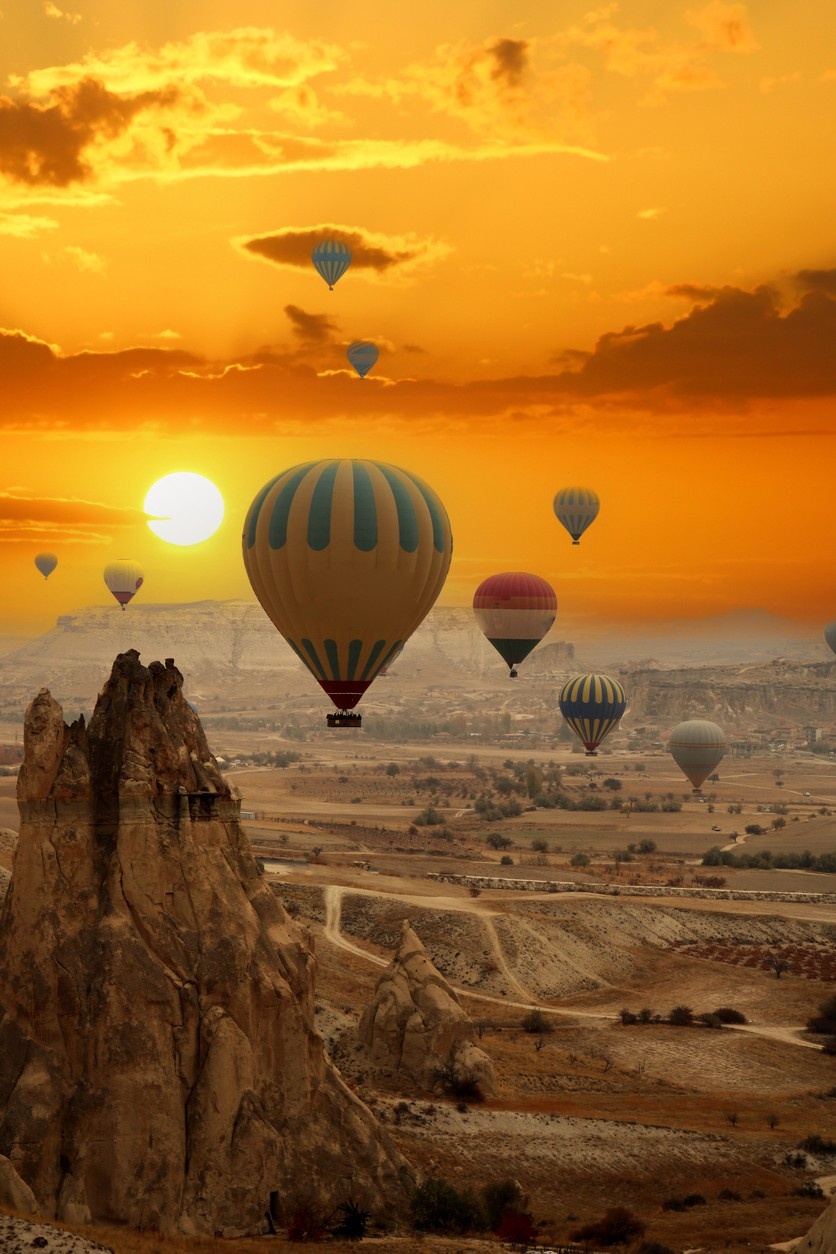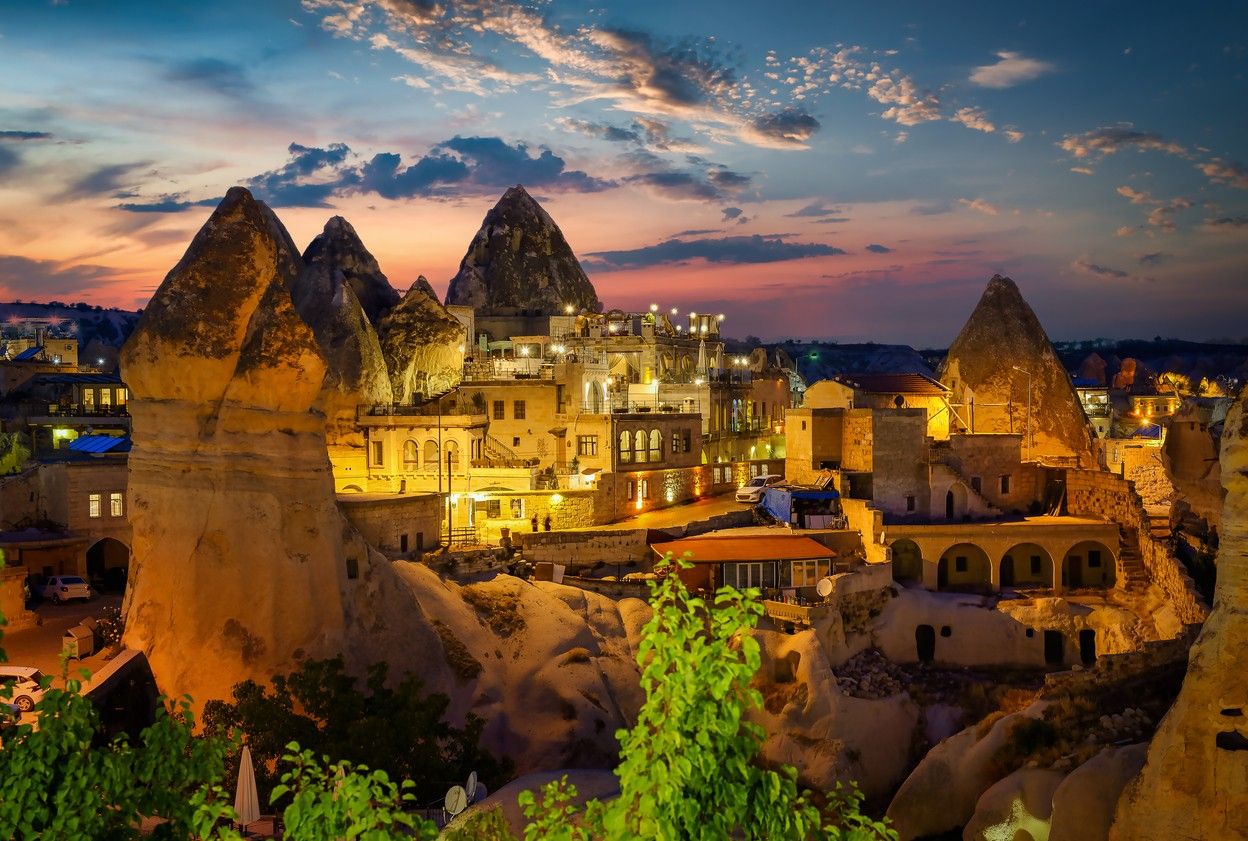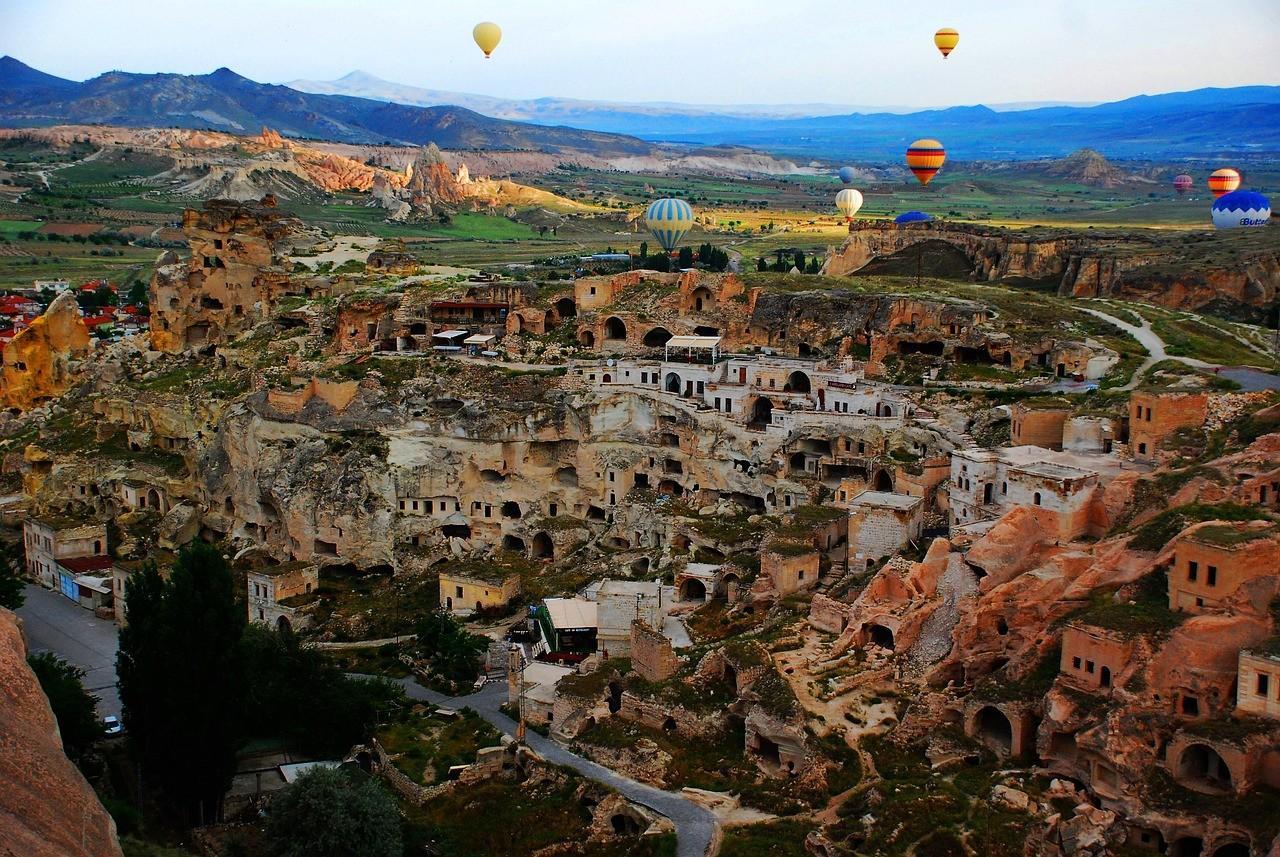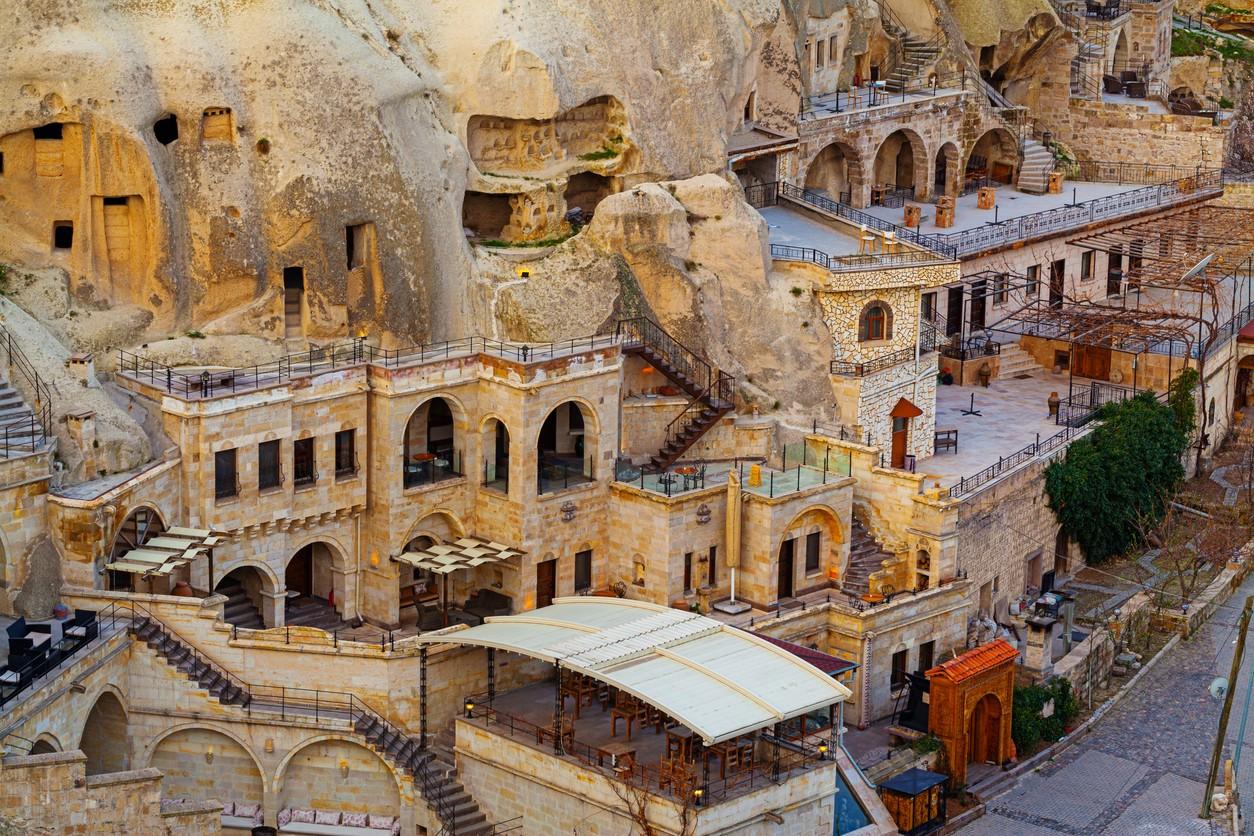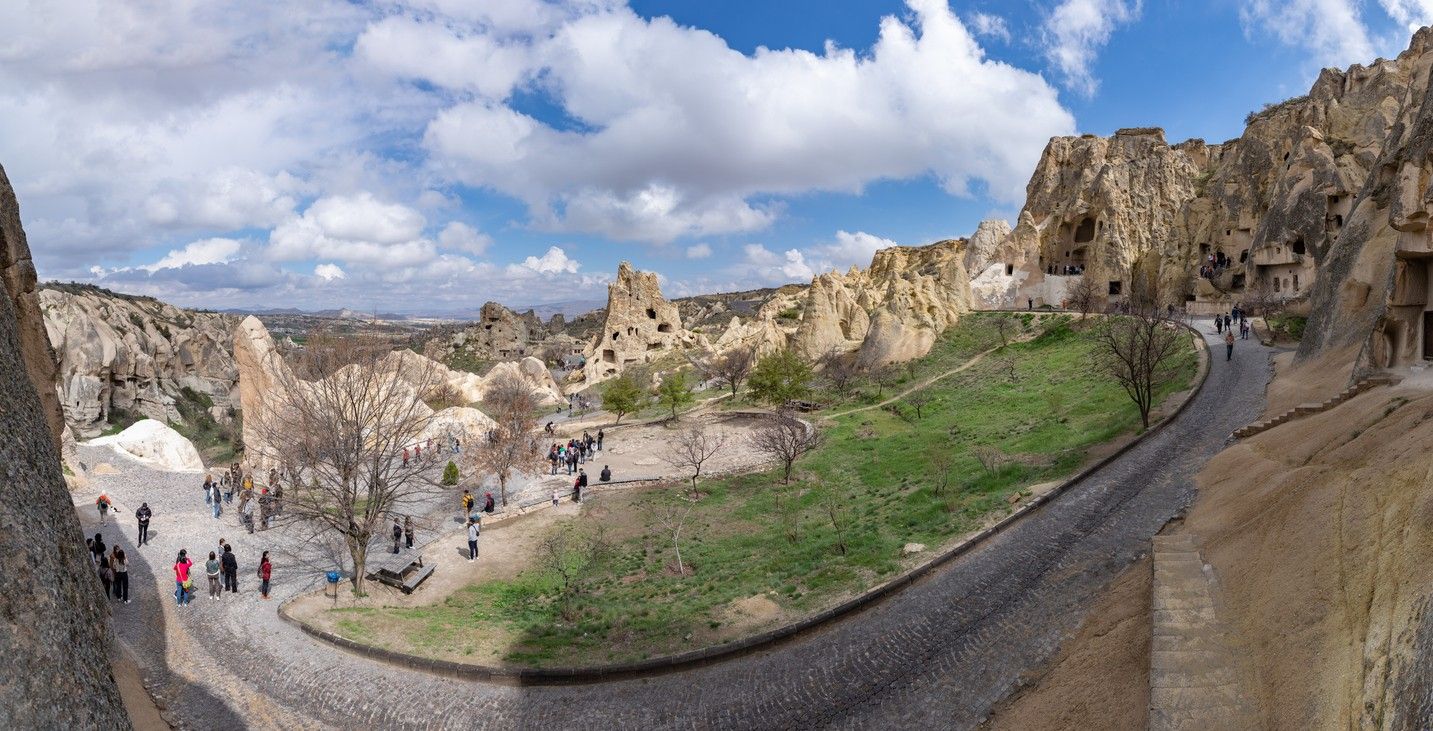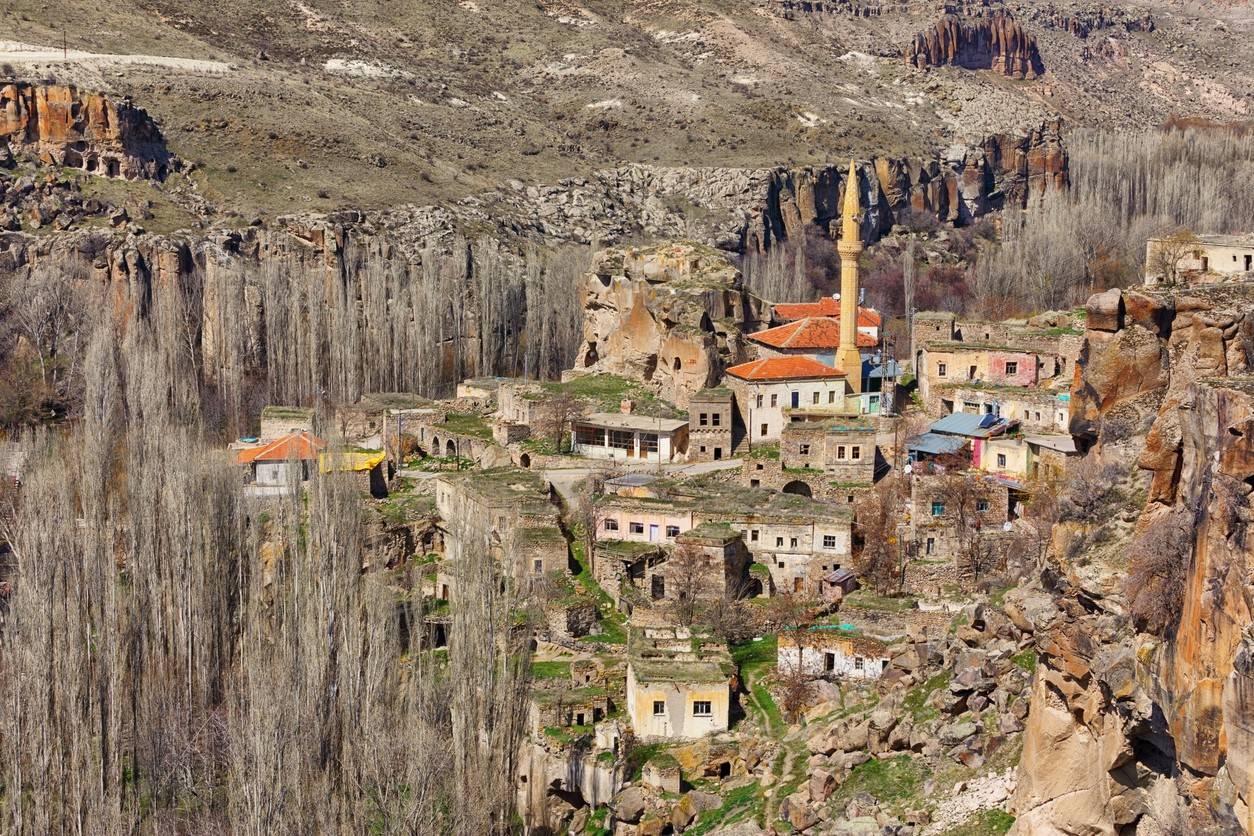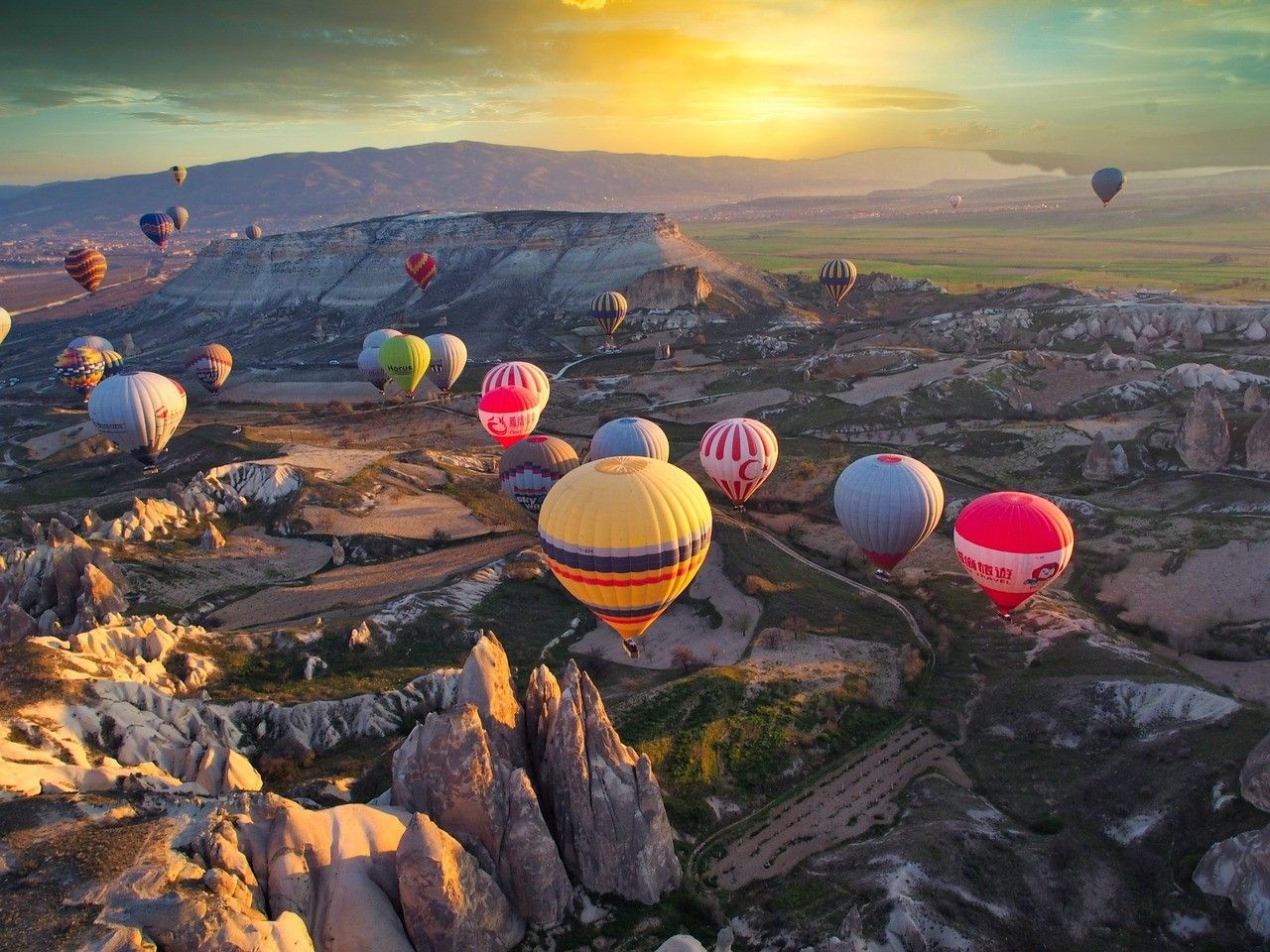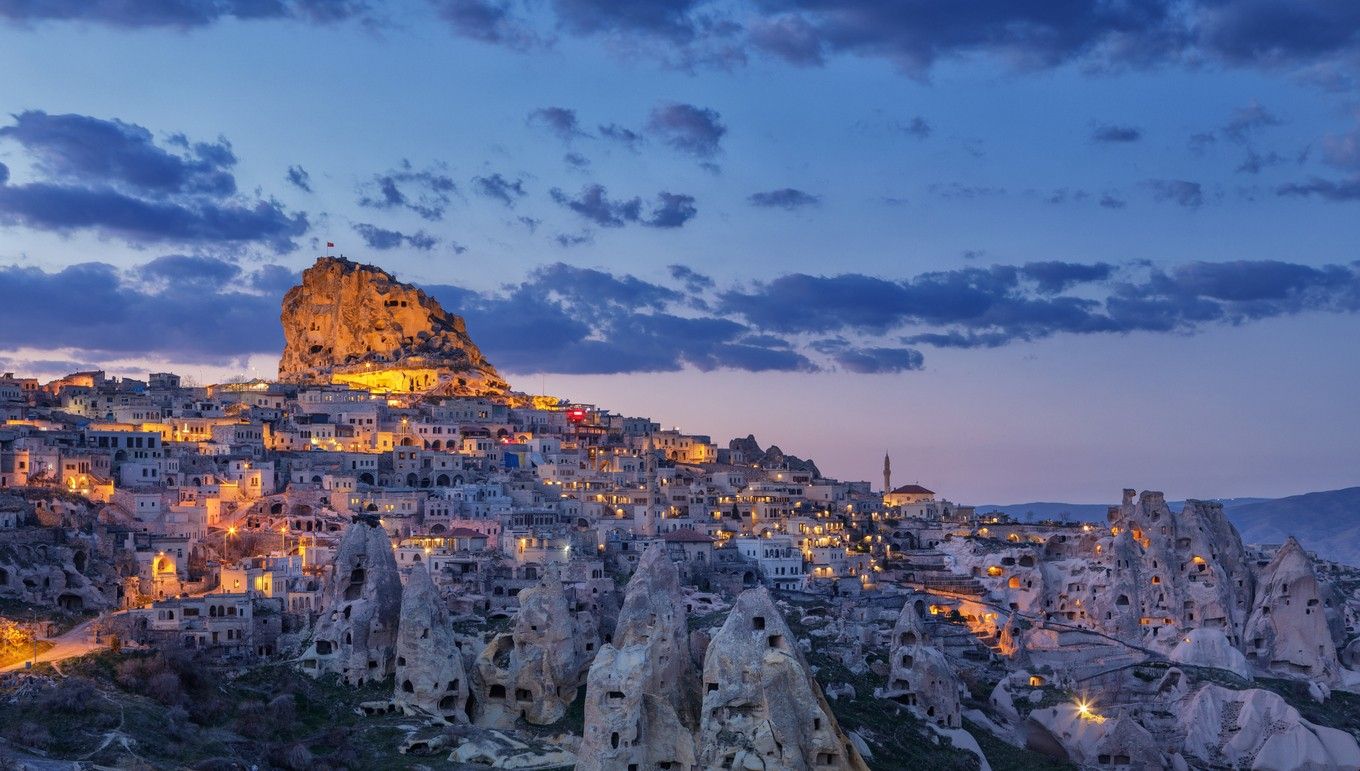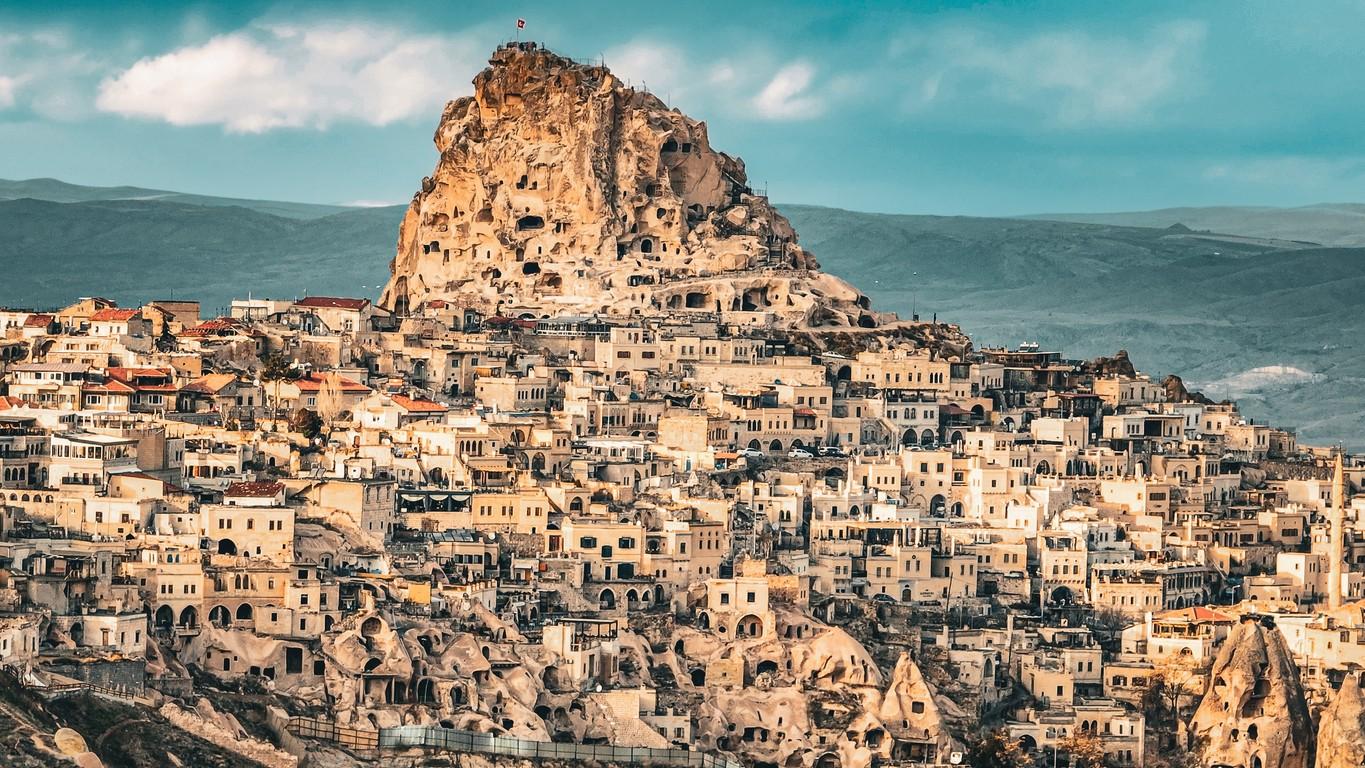Cappadocia, located in the heart of Turkey, is a region that captivates visitors with its breathtaking landscapes, rich history, and unique cultural heritage. This enchanting land, shaped by the forces of nature and centuries of human civilisation, offers an unparalleled experience for travellers seeking adventure, beauty, and inspiration. The name "Cappadocia" is believed to have Persian origins, translating to "the land of beautiful horses." While the region is indeed known for its majestic equine inhabitants, it is the surreal geological formations that truly steal the show and define Cappadocia's otherworldly charm. Millions of years ago, volcanic eruptions blanketed the area in thick layers of ash and lava, which eventually cooled and solidified into soft, porous rock. Over time, wind and water eroded the landscape, carving out the iconic fairy chimneys that now define Cappadocia's surreal terrain. These towering, cone-shaped rock formations rise from the earth like giant, petrified mushrooms, creating a visual spectacle that is both awe-inspiring and humbling.
Exploring the Fairy Chimneys and Cave Dwellings
Cappadocia's iconic fairy chimneys were formed over millions of years by volcanic ash deposits and erosion, creating a surreal landscape of towering rock spires. Early Christian settlers carved intricate dwellings, churches and underground cities into the soft rock, some reaching depths of 280 feet with up to 18 stories. Visitors can explore this fascinating troglodyte architecture and the beautiful frescoes adorning cave churches at sites like the Göreme Open Air Museum
The Iconic Fairy Chimneys of Cappadocia
The fairy chimneys of Cappadocia are one of the most remarkable and iconic features of this fascinating region in central Turkey. These towering, cone-shaped rock formations rise from the earth like giant, petrified mushrooms, creating a surreal and otherworldly landscape that captivates visitors from around the globe. The fairy chimneys are the result of a complex geological process that began millions of years ago when volcanic eruptions blanketed the area in thick layers of ash and lava. As this volcanic material cooled and solidified, it formed a soft, porous rock called tuff, which is easily eroded by wind and water. Over the centuries, the forces of nature have sculpted the tuff into the whimsical shapes that we see today, with some fairy chimneys reaching heights of up to 40 meters (130 feet). The varying hardness of the rock layers has resulted in a process called differential erosion, where the softer layers are worn away more quickly than the harder layers above them. This has created the distinctive conical shape of the fairy chimneys, with their wide bases tapering up to narrow, pointed tops. The colours of the fairy chimneys are just as remarkable as their shapes, with the rock displaying a stunning array of hues ranging from pale pink and yellow to deep red and orange. These colours are the result of the different minerals present in the volcanic rock, with iron oxide creating the reddish tones and other minerals contributing to the lighter shades. As the sun moves across the sky throughout the day, the colours of the fairy chimneys seem to shift and change, creating a beautiful display of light and shadow.
Exploring the valleys and canyons of Cappadocia, visitors are treated to an endless variety of fairy chimneys, each one more fascinating and unique than the last. Some are tall and slender, resembling giant needles piercing the sky, while others are shorter and more stout, with bulbous tops that look like they could topple over at any moment. Many of the fairy chimneys are clustered together in dense groups, creating a forest of stone that stretches as far as the eye can see. One of the most popular spots to view the fairy chimneys is the Göreme Open Air Museum, a UNESCO World Heritage site that features a collection of ancient cave churches and monasteries carved into the soft rock. Here, visitors can wander among the towering spires and marvel at the intricate frescoes and carvings that adorn the walls of the religious structures. Another popular destination is the Pasabag Valley, also known as the Valley of the Monks, where visitors can hike among the fairy chimneys and explore the hidden caves and dwellings that are scattered throughout the landscape.
Cappadocia's iconic fairy chimneys were formed over millions of years by volcanic ash deposits and erosion, creating a surreal landscape of towering rock spires. Early Christian settlers carved intricate dwellings, churches and underground cities into the soft rock, some reaching depths of 280 feet with up to 18 stories. Visitors can explore this fascinating troglodyte architecture and the beautiful frescoes adorning cave churches at sites like the Göreme Open Air Museum.
The Ancient Cave Dwellings and Their Significance
The fairy chimneys of Cappadocia are not only a natural wonder but also a cultural treasure, with a rich history of human habitation dating back thousands of years. Throughout the centuries, the people of Cappadocia have carved homes, churches, and monasteries into the soft volcanic rock, creating a vast network of underground cities and cave dwellings that have served as refuge and sanctuary for countless generations. The earliest known inhabitants of the region were the Hittites, who carved their homes into the rock as early as the 8th century BCE. Over time, other civilisations, including the Persians, Greeks, Romans, and Byzantines, also made their mark on the landscape, expanding and adapting the cave dwellings to suit their needs. During the early centuries of Christianity, Cappadocia became a centre of monastic life, with countless monks and nuns seeking solitude and spiritual enlightenment in the region's caves and underground cities. One of the most remarkable examples of Cappadocia's cave dwellings is the Göreme Open Air Museum, a complex of ancient monasteries and churches carved into the soft tuff. The museum features a collection of stunning frescoes and intricate carvings that date back to the 10th and 11th centuries, offering a glimpse into the rich religious and artistic heritage of the Byzantine era. Visitors can explore the dimly lit chambers and winding tunnels of the monasteries, marvelling at the skill and devotion of the monks who once called these caves home.
Another fascinating aspect of Cappadocia's cave dwellings is their role as places of refuge and protection during times of conflict and persecution. Throughout history, the region has been invaded and occupied by various foreign powers, from the Arabs and Seljuks to the Ottomans and beyond. During these turbulent times, the people of Cappadocia sought safety and security in their underground cities and hidden caves, using them as a means of escape and resistance against their oppressors. The cave dwellings also served as a vital source of shelter and protection from the harsh Anatolian climate, with their thick walls and stable temperatures providing a welcome respite from the scorching summers and frigid winters. The caves were also used for storage and food preservation, with many featuring built-in wine and oil presses, granaries, and water cisterns. Today, many of Cappadocia's cave dwellings have been restored and converted into unique hotels, restaurants, and cultural centres, offering visitors a chance to experience the region's rich history and cultural heritage firsthand. Staying in a cave hotel is a truly unforgettable experience, with the cool, quiet chambers providing a peaceful and contemplative atmosphere that is hard to find in the modern world.
Discovering the Underground City of Derinkuyu
The underground city of Derinkuyu is a vast subterranean complex, which descends over 60 meters (200 feet) into the earth, is a testament to the ingenuity and determination of the ancient Cappadocians, who carved out a sprawling network of tunnels, chambers, and passageways that could shelter up to 20,000 people in times of danger. The origins of Derinkuyu are shrouded in mystery, with some scholars suggesting that the earliest parts of the city may have been excavated by the Hittites as early as the 8th century BCE. Over the centuries, successive generations of Cappadocians expanded and refined the underground city, adding new levels, rooms, and amenities to accommodate the growing population and changing needs of the community.
At its peak, Derinkuyu was a fully functioning city, with all the features and conveniences of a surface settlement. The complex included living quarters, kitchens, storerooms, wineries, oil presses, stables, and even a school and church, all carved out of the soft volcanic rock. The city was also equipped with an elaborate ventilation system, with numerous air shafts and chimneys providing fresh air and light to the underground chambers. Derinkuyu is known for its sophisticated defence system, which included heavy stone doors that could be rolled into place to block off entire sections of the city in case of attack. The doors were operated from the inside, allowing the inhabitants to seal themselves off from the outside world and wait out any threat to safety and security.
Exploring Derinkuyu today is a truly unforgettable experience, with visitors descending into the depths of the earth through a series of narrow, winding passageways and steep staircases. The underground city is divided into eight levels, with the deepest reaching a depth of around 85 meters (280 feet). Each level is connected by a network of tunnels and chambers, with many of the rooms still bearing the marks and scars of the tools used to carve them out of the rock. Derinkuyu has a large central chamber on the second level, which features a soaring, vaulted ceiling and a series of smaller rooms and antechambers branching off from it. This chamber is believed to have served as a gathering place and religious centre for the underground community, with the smaller rooms used for prayer, study, and reflection. Derinkuyu has a fascinating network of underground tunnels that connect it to other nearby underground cities, such as Kaymakli and Ozkonak. These tunnels, some of which stretched for several kilometres, allowed the inhabitants of the different cities to communicate and trade with each other, creating a vast underground network that spanned the entire region.
Soaring Above the Landscape in a Hot Air Balloon
Taking a hot air balloon ride at sunrise is a signature Cappadocia experience, offering breathtaking aerial views of the fairy chimneys and cave dwellings. Floating serenely over the otherworldly landscape as the sun bathes the rocks in warm hues is considered one of the world's top ballooning adventures. Rides are suitable for all ages and include a champagne toast upon landing to celebrate the unforgettable journey
The Magic of Hot Air Balloon Rides in Cappadocia
Cappadocia, a region in central Turkey, is renowned for its breathtaking landscapes and unique geological formations. Among the many attractions that draw visitors from around the world, hot air balloon rides have become an iconic and unforgettable experience. The magic of floating gently above the fairy chimneys, valleys, and ancient cave dwellings is an adventure that captures the hearts of all who embark upon it. The hot air balloon rides in Cappadocia typically begin in the early morning, just before sunrise. As the first rays of sunlight paint the sky in an array of colours, the balloons are inflated, and passengers climb into the baskets, ready to ascend into the heavens. The anticipation builds as the skilled pilots ignite the burners, and the balloons slowly rise from the ground, carrying their passengers on a journey like no other. As the balloons gain altitude, the true beauty of Cappadocia unfolds beneath them. The unique landscape, shaped by millions of years of volcanic activity and erosion, is a sight to behold. The fairy chimneys, towering spires of rock carved by the elements, stand tall amidst the undulating valleys and canyons. The soft light of the rising sun casts long shadows across the land, creating an ethereal atmosphere that seems to belong to another world.
The sheer number of balloons that take to the skies each morning is truly magical. On a clear day, it is not uncommon to see over 100 balloons floating above the fairy chimneys, creating a spectacular sight that is truly unforgettable. The colourful balloons dotting the sky, set against the backdrop of the ancient landscape, create a scene that seems to belong in a fairy tale. As the flight continues, passengers have the opportunity to take in the stunning views from a variety of angles. The skilled pilots manoeuvre the balloons to provide optimal vantage points, allowing passengers to capture breathtaking photographs and create lasting memories. The experience of floating silently above the earth, with nothing but the gentle breeze and the occasional sound of the burners, is a moment of pure magic that will stay with passengers long after they return to the ground.
The hot air balloon rides in Cappadocia typically last between 45 minutes to an hour, depending on the weather conditions and the specific tour company. During this time, passengers have the opportunity to fully immerse themselves in the beauty of the landscape and the magic of the experience. As the flight comes to an end, the balloons gently descend back to the earth, landing softly in the valleys below. Upon landing, passengers are greeted with a traditional champagne toast, a celebration of the unforgettable journey they have just experienced. The sense of camaraderie and shared adventure among the passengers is palpable, as they reflect on the magical moments they have just shared. The hot air balloon rides in Cappadocia are not just a tourist attraction; they are a true celebration of the beauty and wonder of the natural world. The experience of floating above this ancient landscape, witnessing the sunrise paint the sky in a kaleidoscope of colours, is a moment of pure magic that will leave an indelible mark on the hearts of all who have the privilege of experiencing it.
Alternative Ways to Explore Cappadocia from Above
While hot air balloon rides are undoubtedly the most popular and iconic way to explore Cappadocia from above, they are by no means the only option. For those seeking a more adrenaline-fueled adventure or a different perspective on the stunning landscape, there are several alternative ways to take to the skies and witness the beauty of Cappadocia from a unique vantage point.
An alternative way to explore Cappadocia from above is by taking a helicopter tour. These tours, which typically last between 15 and 30 minutes, offer a thrilling and unforgettable way to see the landscape from a new perspective. Unlike hot air balloons, which drift gently with the wind, helicopters can cover large distances quickly and provide a more dynamic and immersive experience. During a helicopter tour of Cappadocia, passengers can expect to fly over some of the region's most iconic landmarks, including the fairy chimneys, valleys, and ancient cave dwellings. The skilled pilots navigate the helicopters with precision, ensuring that passengers have ample opportunity to take in the stunning views and capture breathtaking photographs. Helicopter tours can be tailored to the specific interests and preferences of the passengers. Some tours focus on the geological wonders of the region, while others highlight the historical and cultural significance of the ancient cave dwellings and underground cities. Regardless of the focus, helicopter tours provide a unique and unforgettable way to experience the beauty of Cappadocia from above.
Another alternative way to explore Cappadocia from above is by taking a paragliding or parasailing tour. These tours, which involve flying through the air while attached to a parachute or glider, offer a more hands-on and immersive way to experience the landscape. Unlike hot air balloons or helicopters, which are piloted by experienced professionals, paragliding and parasailing tours allow passengers to take a more active role in the experience. During a paragliding or parasailing tour of Cappadocia, passengers are strapped into a harness and attached to a parachute or glider. The skilled instructors provide a brief training session and safety briefing before launching the passengers into the air. Once airborne, passengers can soar like a bird over the stunning landscape, taking in the breathtaking views and experiencing the thrill of flying through the air. Paragliding and parasailing tours offer a more intimate and personal way to experience the beauty of Cappadocia from above. Passengers can feel the rush of the wind in their faces and the exhilaration of soaring through the sky, creating a sense of connection with the landscape that is difficult to achieve through other means.
For those who prefer a more leisurely and relaxed way to explore Cappadocia from above, hot air balloon rides are not the only option. Several tour companies offer scenic flights in small aircraft, which provide a comfortable and convenient way to take in the stunning views of the region. During a scenic flight over Cappadocia, passengers can sit back and relax in the comfort of a small plane or helicopter, taking in the breathtaking views of the landscape below. The skilled pilots navigate the aircraft over the most iconic landmarks and scenic areas, providing passengers with a comprehensive overview of the region's beauty and diversity.
Discovering the Region's Rich History and Culture
Cappadocia has a long and storied history of settlement dating back to the Hittites, with Romans, Persians, early Christians, Seljuks and Ottomans all leaving their mark over the centuries. In addition to its troglodyte dwellings, the region is dotted with impressive caravanserais, or fortified inns, that once accommodated Silk Road travellers.
The Ancient History of Human Settlement in Cappadocia
Cappadocia has a rich and fascinating history of human settlement that dates back thousands of years. The earliest evidence of human habitation in the area comes from the Paleolithic era, when small groups of hunter-gatherers roamed the landscape in search of food and shelter. Over time, these early settlers began to establish more permanent communities, taking advantage of the region's abundant natural resources and unique geological features. Cappadocia has had successive civilisations that have left their mark on the landscape. From the Hittites and Persians to the Greeks, Romans, and Byzantines, each culture has contributed to the rich tapestry of Cappadocian history and culture. The Hittites, who ruled the region from the 18th to the 13th centuries BCE, were among the first to establish major settlements in Cappadocia. They built impressive fortresses and temples, many of which were carved directly into the soft volcanic rock that characterises the region's landscape. The Hittites also developed sophisticated systems of agriculture and trade, laying the foundation for the region's future prosperity. In the centuries that followed, Cappadocia came under the influence of a succession of powerful empires, including the Persians, Greeks, and Romans. Each of these cultures left its mark on the region, building grand monuments, establishing thriving cities, and leaving behind a rich legacy of art, architecture, and literature.
Cappadocia's ancient history began in the 4th century CE when the region became a centre of early Christian monasticism. Seeking solitude and spiritual enlightenment, countless monks and nuns flocked to Cappadocia, where they established monasteries and churches carved directly into the rocky cliffs and fairy chimneys that dot the landscape. These early Christian settlers developed a unique and vibrant culture, characterised by a deep devotion to faith and a remarkable artistic tradition. The frescoes, paintings, and sculptures that adorn the walls of Cappadocia's ancient churches and monasteries are among the most stunning examples of Byzantine art in the world and continue to inspire and amaze visitors to this day. As the centuries passed, Cappadocia's strategic location at the crossroads of Europe and Asia made it a vital centre of trade and commerce. The region's rich natural resources, including its abundant supplies of volcanic tuff, made it an important centre of mining and craftsmanship, while its position along the ancient Silk Road made it a hub of international trade and cultural exchange.
The Göreme Open Air Museum and Its Frescoed Churches
The Göreme Open Air Museum is a UNESCO World Heritage site and one of the most popular attractions in Cappadocia. This stunning complex of ancient churches, chapels, and monasteries is a testament to the region's rich history and cultural heritage and offers visitors a unique and unforgettable glimpse into the world of early Christian monasticism. The museum is located just outside the town of Göreme, in the heart of Cappadocia's fairy chimney landscape. The site was first settled by Byzantine monks in the 4th century, who carved churches and monasteries directly into the soft volcanic rock. Over the centuries, the complex grew and expanded, becoming a major centre of religious life and artistic expression. Today, the Göreme Open Air Museum is home to a stunning collection of rock-cut churches and chapels, each one adorned with beautiful frescoes and intricate carvings. These works of art, which date back to the 10th and 11th centuries, depict scenes from the Bible and the lives of saints and are considered some of the finest examples of Byzantine art in the world.
One of the most impressive churches in the museum is the Buckle Church, also known as the Tokalı Church. This large, multi-level church features a series of stunning frescoes that depict the life of Christ, from his birth to his crucifixion and resurrection. The colours of the frescoes are still vibrant and well-preserved, thanks in part to the fact that the church was protected from the elements by its location inside the rock. Another highlight of the museum is the Dark Church, so named because of the limited natural light that enters the interior. Despite the dim lighting, the frescoes inside the Dark Church are some of the most beautiful and well-preserved in the entire complex, with vivid colours and intricate details that continue to amaze visitors.
Other beautiful churches in the Göreme Open Air Museum include the Apple Church, the Snake Church, and the Chapel of St. Barbara. Each of these churches has its unique character and charm, with frescoes and carvings that reflect the artistic and spiritual traditions of the Byzantine era. In addition to the churches and chapels, the Göreme Open Air Museum also includes many other structures and features that offer a glimpse into the daily life of the monks and nuns who once lived here. These include kitchens, dining halls, and living quarters, as well as a network of tunnels and passageways that connect the various buildings.
The Ancient Monasteries of the Ihlara Valley
The Ihlara Valley, located in the southern part of Cappadocia, is a lush, verdant canyon that is home to some of the region's most stunning and well-preserved ancient monasteries. This beautiful valley, which stretches for over 100 kilometres, was once a major centre of early Christian monasticism, and today offers visitors a unique and fascinating glimpse into the spiritual and artistic traditions of the Byzantine era. The monasteries of the Ihlara Valley were first established in the 4th century when monks and nuns began carving churches and living quarters directly into the soft volcanic rock that lines the canyon walls. Over the centuries, these monasteries grew and expanded, becoming major centres of religious life and artistic expression.
One of the most impressive monasteries in the Ihlara Valley is the Selime Monastery, which dates back to the 13th century. This massive complex, which is carved into a towering rock formation, includes a large church, a refectory, and many living quarters and other structures. The church at Selime Monastery is particularly stunning, with beautiful frescoes and intricate carvings that reflect the artistic and spiritual traditions of the Byzantine era. Another notable monastery in the Ihlara Valley is the Yılanlı Church, also known as the Church of the Serpents. This small, intimate church is named for the serpentine motifs that adorn its walls and ceilings and is considered one of the most beautiful and well-preserved examples of Byzantine art in the region.
Other monasteries in the Ihlara Valley include the Ağaçaltı Church, the Kokar Church, and the Pürenli Church, each of which has its unique character and charm. These monasteries are scattered throughout the valley, often hidden away in the cliffs and caves that line the canyon walls, and offer visitors a chance to explore the rich history and cultural heritage of the region. To explore the monasteries of the Ihlara Valley, visitors can hike along the many trails that wind through the canyon, stopping to admire the stunning views and explore the various churches and living quarters along the way. Many of the monasteries are open to the public and offer guided tours and other educational programs that provide insight into the history and significance of these remarkable structures.
The Imposing Uçhisar Castle and Its Significance
Uçhisar Castle, perched atop the highest point in Cappadocia, is a striking example of the region's rich history and strategic importance. This massive rock formation, which has been hollowed out and fortified over the centuries, served as a natural fortress and lookout point for the various civilisations that have called Cappadocia home. The origins of Uçhisar Castle are somewhat shrouded in mystery, but it is believed to have been first settled by the Hittites, an ancient civilisation that ruled the region from the 18th to the 13th centuries BCE. Over the centuries, the castle was expanded and fortified by successive cultures, including the Persians, Greeks, Romans, and Byzantines. During the Byzantine era, Uçhisar Castle served as an important military outpost, guarding the strategic trade routes that passed through the region. The castle's location atop a high rock formation made it an ideal spot for monitoring the surrounding landscape, and its complex network of tunnels and chambers provided a secure refuge for soldiers and civilians alike.
In addition to its military significance, Uçhisar Castle also played an important role in the religious life of the region. The castle is home to some ancient churches and chapels, many of which are carved directly into the rock face. These religious structures, which date back to the 10th and 11th centuries, are adorned with beautiful frescoes and intricate carvings that reflect the artistic and spiritual traditions of the Byzantine era. Uçhisar Castle is a very popular tourist attraction in Cappadocia, drawing visitors from around the world who come to marvel at its impressive size and stunning views. The castle is open to the public, and visitors can explore its many chambers and tunnels, climb to the top for panoramic views of the surrounding landscape, and learn about its rich history and cultural significance. The castle is carved out of a massive rock formation that rises over 60 meters above the surrounding landscape, and its complex network of tunnels and chambers extends deep into the earth. Visitors can spend hours exploring the various levels and rooms of the castle, each one offering a unique glimpse into the lives of the people who once lived and worked here.
Planning Your Cappadocian Adventure
With so much to see and do, careful planning will help you make the most of your Cappadocia trip. Choosing a central base like Göreme, booking activities like balloon rides and tours in advance, and opting for comfortable walking shoes and layered clothing are all recommended. Be sure to allow ample time to explore off-the-beaten-path gems in addition to top sites, and indulge in memorable experiences like staying in a cave hotel or dining on local specialties
Choosing Your Base: Göreme and Other Options — When planning your Cappadocian adventure, one of the first decisions you'll need to make is where to base yourself. The charming town of Göreme is a popular choice, thanks to its central location and abundance of cave hotels and restaurants. However, there are many other options to consider, from the larger town of Ürgüp to the smaller, more intimate villages of Uçhisar and Ortahisar. Each location has its unique character and charm, so be sure to do your research and choose the one that best suits your needs and preferences.
Getting Around Cappadocia: Car Rentals, Private Drivers, and Guided Tours — Cappadocia is a vast and sprawling region, with many of its most famous attractions spread out over a wide area. To make the most of your time here, you'll need to plan your transportation carefully. Renting a car or hiring a private driver can be a convenient way to explore the region at your own pace, allowing you to stop and take in the sights whenever and wherever you please. Alternatively, guided tours can be a great option for those who prefer a more structured approach, with knowledgeable local guides leading the way and sharing their insights and expertise.
Hiking Through the Rose-Tinted Valleys of Pasabag — The Pasabag Valley, also known as the Valley of the Monks, is one of Cappadocia's most enchanting hiking destinations. This stunning landscape, characterised by its rose-tinted rock formations and towering fairy chimneys, is a true wonder of nature. As you wander through the valley, you'll discover hidden caves, ancient dwellings, and breathtaking vistas at every turn. Be sure to bring plenty of water and sunscreen, as the Cappadocian sun can be intense, even in the cooler months.
Watching the Sunset Paint the Fairy Chimneys — One of the most magical moments in Cappadocia is watching the sunset paint the fairy chimneys in a breathtaking array of colours. As the sun dips below the horizon, the landscape is transformed into a sea of gold, orange, and crimson, with the towering rock formations casting long shadows across the valleys and canyons. Whether you're perched atop a viewpoint or simply wandering through the streets of a local village, this is a sight that will stay with you forever.
Stargazing Under the Clear Anatolian Sky — Cappadocia's remote location and lack of light pollution make it an ideal destination for stargazing. On a clear night, the Anatolian sky comes alive with a dazzling array of stars, planets, and constellations, offering a truly humbling and awe-inspiring experience. Many local hotels and tour operators offer stargazing experiences, complete with telescopes and expert guidance, allowing you to delve even deeper into the wonders of the night sky.
Related Articles

Let us know you agree to cookies
We use marketing, analytical and functional cookies as well as similar technologies to give you the best experience. Third parties, including social media platforms, often place tracking cookies on our site to show you personalised adverts outside of our website.
We store your cookie preferences for two years and you can edit your preferences via ‘manage cookies’ or through the cookie policy at the bottom of every page. For more information, please see our cookie policy.
